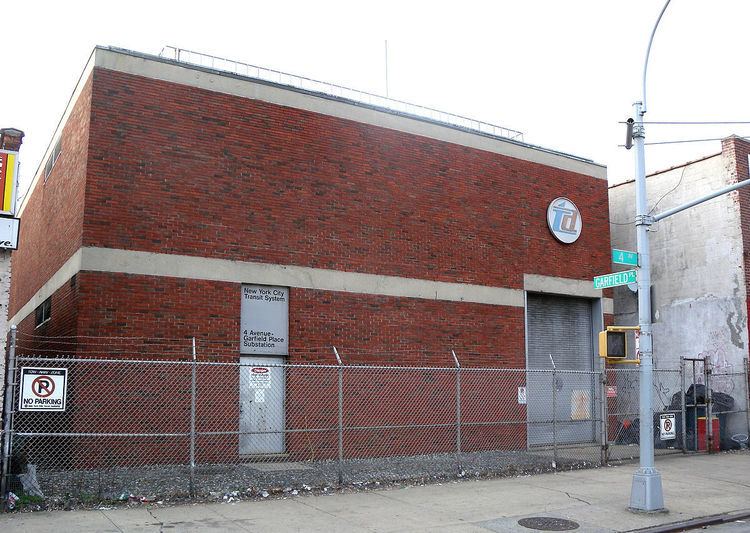Type Rapid transit line Status Operational | System New York City Subway Stations 16 | |
 | ||
Locale Brooklyn, New York City, NY Termini Court StreetBay Ridge–95th Street Similar IND Eighth Avenue Line, 63rd Street Lines, Archer Avenue Lines | ||
The Fourth Avenue Line is a rapid transit line of the BMT division of the New York City Subway, mainly running under Fourth Avenue in Brooklyn. Fourth Avenue never had a streetcar line or elevated railway due to the provisions of the assessment charged to neighboring property owners when the street was widened. The line is served by the D, N, and R. One station, Myrtle Avenue, was abandoned in 1956.
Contents
Route
Coming south from DeKalb Avenue and off of Fulton Street, the four-track line runs entirely under Fourth Avenue to just past 59th Street. South of 36th Street, the West End Line (formerly the New Utrecht Avenue elevated line) branches off eastwards, running to its terminus at Coney Island–Stillwell Avenue. Until 1954, the BMT Culver Line also branched off from here, replaced by the Culver Shuttle until 1975. South of 59th Street, after the Sea Beach Line branches off eastwards towards Coney Island via an open-cut right-of-way, the line becomes two-tracked and continues under Fourth Avenue to its terminus at Bay Ridge–95th Street. While this section of the line was built with two tracks, there were provisions to add two additional express tracks between 59th and 85th Streets if the need was ever to arise.
In its upper section, the line serves Brooklyn Heights and Downtown Brooklyn. The central section serves Park Slope east of Fourth Avenue, on the west side, Boerum Hill then Gowanus; and Sunset Park. In its lower section, it serves the community of Bay Ridge.
Services
The following services use the Fourth Avenue Line:
The line normally carries the Fourth Avenue R service on the local tracks and the Sea Beach N and West End D services on the express tracks. During weekdays, three local N trains per day, in each direction, are designated as W. Manhattan-bound from DeKalb Avenue, the local tracks run via the Montague Street Tunnel to Lower Manhattan, serving either Whitehall Street on the BMT Broadway Line (N, R) or Broad Street on the BMT Nassau Street Line (no service; the last service to use these tracks was the M, rerouted in 2010). The express tracks go to Manhattan via the Manhattan Bridge to either the BMT Broadway Line's Canal Street express station (N) or the IND Sixth Avenue Line's Grand Street station (D).
History
The Fourth Avenue Line was built as part of the Dual Contracts. It replaced the parallel elements of an old, now long-ago-demolished elevated system running above Fifth Avenue and Third Avenue.
Groundbreaking for the first section of the subway, between DeKalb Avenue and 43rd Street (ending at 36th Street), took place in November 1909 at DeKalb and Flatbush Avenue. Construction on the southernmost section of the line to 89th Street, just south of the 86th Street station, began in late October 1912. The lower section of the line was constructed along with several branch lines, which replaced former surface railroads. These lines are the BMT West End Line splitting south of 36th Street, and the BMT Sea Beach Line leaving south of 59th Street. In anticipation of the opening of the subway, several housing and development booms occurred along Fourth Avenue, particularly in Bay Ridge.
The line opened from 59th Street to 86th Street on January 15, 1916. The final extension to 95th Street opened on October 31, 1925.
The line was planned to be connected via one of two tunnels to Staten Island and the Staten Island Railway. The first would be in Bay Ridge, south of the 59th Street station, connecting to both SIR branches near the Tompkinsville station. The other would have been south of 95th Street in Fort Hamilton, following the current routing of the Verrazano–Narrows Bridge. Construction on the first plan, known as the Staten Island Tunnel was started in 1923 but soon halted. Later proposals called for connecting the line and the SIR via the Verrazano Bridge, though the bridge was built with no railroad provisions.
The Myrtle Avenue station closed on July 16, 1956 for the reconstruction of the flying junction north of DeKalb Avenue to increase capacity for the entire BMT Division. The Brooklyn-bound platform was removed completely, but the Manhattan-bound platform still exists.
Formerly, the Fourth Avenue Line served trains from the BMT Culver Line, which connected to the 36th Street station via the lower level of the Ninth Avenue station south of Green-Wood Cemetery from a now-demolished elevated structure. Following the connection of the Culver Line to the South Brooklyn Line of the IND in 1954, the only access to the line from the 4th Avenue subway was via the Culver Shuttle at Ninth Avenue. Shuttle service ended in 1975, with homes and housing developments erected over the right-of-way of the two demolished stations in the 1980s and again in the 2010s. The barest stub of the old elevated line is still visible at Ditmas Avenue.
In January 2017, the MTA revealed plans to rehabilitate the structure of the tunnel above the express tracks between 36th and 59th Streets. The structure had become corroded because resurfacing of Fourth Avenue in the 2010s caused rainwater to seep into the structure rather into the sewage system. The tracks will be closed between May 2018 and May 2019.
Chaining information
The Fourth Avenue Line is chained BMT F.
